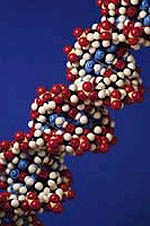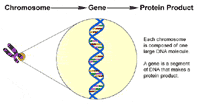Genetics
What is genetics?

Genetics is the study of the patterns of inheritance--how traits and characteristics are passed from parents to their children. Genes are formed from segments of DNA (deoxyribonucleic acid), the molecule that encodes genetic information in the cells. DNA controls the structure, function, and behavior of cells and can create exact copies of itself.
Humans have an estimated 25,000 different genes that contain specific genetic information. These genes are located on chromosomes (stick-like structures in the nucleus of cells). Every cell contains 46 chromosomes grouped in 23 pairs. The gamete (egg or sperm) from each parent only contains one half of each chromosome pair. When the two gametes unite and the egg is fertilized, the single chromosomes from each parent join again to form new pairs. The baby's gender is determined by one of the chromosome pairs: females have two X chromosomes and males have one X and one Y chromosome.
Genes are lined up on the chromosomes in specific positions and locations. Although these locations are the same for each pair of chromosomes, the genes may be similar or different. Just as traits, such as blue eyes and curly hair, are passed from the genetic information of the parents to a baby, inherited diseases and abnormalities can also be passed on. Some disorders are recessive, meaning that the abnormal gene must be received from both parents. Other disorders are dominant, meaning an abnormal gene may come from only one parent for the disorder to occur.
When a gene is abnormal, or when entire chromosomes are missing or duplicated, defects in the structure or function of the body's organs or systems can occur. These mutations or abnormalities can result in disorders, such as cystic fibrosis, a recessive genetic disease, or Down syndrome, a condition that occurs when a baby receives three copies of the #21 chromosome.

Connect with us:
Download our App: